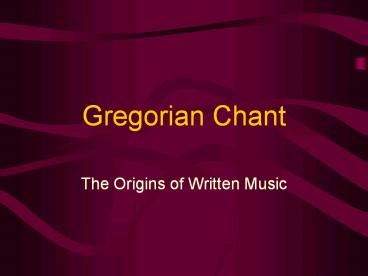Gregorian%20Chant PowerPoint PPT Presentation
Title: Gregorian%20Chant
1
Gregorian Chant
- The Origins of Written Music
2
The History of Gregorian Chant
- Named for Pope St. Gregory the Great (540-604).
- It is believed that Gregory did not write any
chants, but instead organized the many different
schools of chant into one coherent form by
developing the Antiphonary (written music). - The Antiphonary is the oldest surviving form of
written music.
3
What does Gregorian Chant look like?
4
(No Transcript)
5
Gregorian Chant uses a four line staff - instead
of the modern day five line staff
- A Benedictine Monk Named Guido DArezzo is
believed to have created this staff, although
there is some debate over whether or not he
actually did it.
6
(No Transcript)
7
(No Transcript)
8
The beautiful artwork and decorations found
throughout most chants gives them the name
Illuminated Manuscripts.Monks often spent months
creating one chant. After all, what else was
there to do?
9
(No Transcript)
10
What are all those squiggly bits?
11
Those squiggly bits are called NEUMES.
- Neumes are like musical notes without stems. The
shape of each neume determines the rhythm and
pitch of each note. - Neumes eventually became modern day notes.
12
Where is the key signature, the clef, and the
time signature?
13
The Clef is there, but the time signature and key
signature arent.
- Gregorian Chant uses a clef that looks like the
letter C. The clef actually curls around the
line that is middle C. - Gregorian chant does not use a time signature.
It is sung as the words dictate. - All Gregorian chant is sung in a certain mode,
not a key signature.
14
What language are they singing in?
15
Latin
- All of the text is in Latin. The reason for this
is that Gregorian Chant is completely based in
religion (Christianity). - The text is directly from the Bible and sung
during religious services. Each chant has a
specific function, much like Hymns do. - Today, chant is still used in the Catholic and
Eastern Orthodox churches.
16
Why are there only men singing?
17
Women were not allowed to participate in any part
of a religious ceremony in 10th Century Europe.
18
Lets look a bit closer atNEUMES
PowerShow.com is a leading presentation sharing website. It has millions of presentations already uploaded and available with 1,000s more being uploaded by its users every day. Whatever your area of interest, here you’ll be able to find and view presentations you’ll love and possibly download. And, best of all, it is completely free and easy to use.
You might even have a presentation you’d like to share with others. If so, just upload it to PowerShow.com. We’ll convert it to an HTML5 slideshow that includes all the media types you’ve already added: audio, video, music, pictures, animations and transition effects. Then you can share it with your target audience as well as PowerShow.com’s millions of monthly visitors. And, again, it’s all free.
About the Developers
PowerShow.com is brought to you by CrystalGraphics, the award-winning developer and market-leading publisher of rich-media enhancement products for presentations. Our product offerings include millions of PowerPoint templates, diagrams, animated 3D characters and more.

